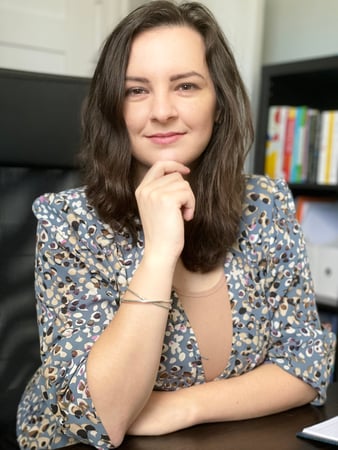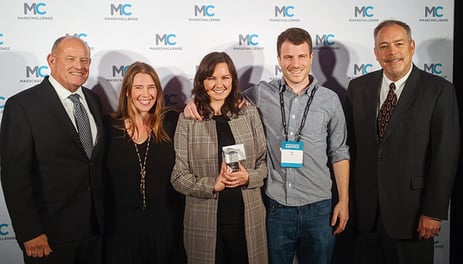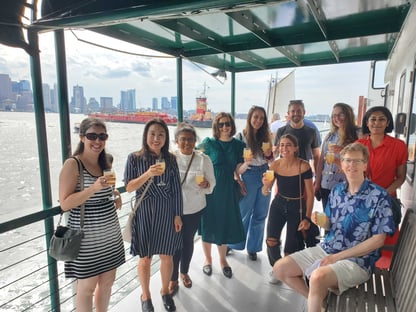When Joanna Stanicka was only 10 years old, she watched helplessly as her 14-year-old cousin, Ania, struggled with severe rheumatoid arthritis. Doctors told her family she would be in a wheelchair for the rest of her life. Instead, Ania enrolled in a clinical trial testing a new disease-modifying biological therapy and within a few months, her symptoms essentially vanished. “I saw Ania’s incredible recovery happen right before my eyes. She went from being completely dependent and almost immobile to a healthy, independent person,” Stanicka says. “I knew then that I wanted to pursue a career in science.”
 Stanicka left Poland at 19 years old to complete her BSc in biochemistry and Ph.D. in cancer cell biology at the University College Cork in Ireland. Her work focused on how genes and proteins impact both healthy and diseased cells with the goal of developing novel cancer therapeutics — and researchers across the globe, including Zhigang He, Ph.D., at Harvard Medical School — began to take notice.
Stanicka left Poland at 19 years old to complete her BSc in biochemistry and Ph.D. in cancer cell biology at the University College Cork in Ireland. Her work focused on how genes and proteins impact both healthy and diseased cells with the goal of developing novel cancer therapeutics — and researchers across the globe, including Zhigang He, Ph.D., at Harvard Medical School — began to take notice.
From Cancer to Neuroscience
When it comes to science, researchers can often apply their knowledge of basic biological tenets across disciplines. With cancer, for example, researchers study how cells grow uncontrollably so they can stall that proliferation. With neuro-regeneration, it’s just the opposite. Scientists try to work around cell death and prompt neurons that reside in the spared tissue to regrow.
“Both processes rely on similar signaling pathways,” Stanicka says. “In one instance, you’re trying to stop cells from growing and in the other, you’re trying to coax cells to grow. The key is targeting only neurons since turning on growth in other cells could lead to tumors.”
One of the nation’s foremost experts in spinal cord injury (SCI), Professor He, wanted Dr. Stanicka to join his lab to help reverse engineer what happens within cancer cells (i.e., activated overgrowth) and apply that knowledge to neuro-regeneration. Around the same time, He’s lab also discovered that spared tissue in mice with an incomplete SCI could be reactivated through restoring the expression of a protein called KCC2.
 A new start-up company called AXONIS evolved out of Dr. He’s research with Dr. Stanicka at the helm. The company’s mission: to marry basic science into translational medicine and spawn a new generation of therapeutics for patients with SCI. Under Dr. Stanicka’s leadership, efforts are underway to develop a new oral drug for people with SCI that helps restore function and reduce pain and spasticity.
A new start-up company called AXONIS evolved out of Dr. He’s research with Dr. Stanicka at the helm. The company’s mission: to marry basic science into translational medicine and spawn a new generation of therapeutics for patients with SCI. Under Dr. Stanicka’s leadership, efforts are underway to develop a new oral drug for people with SCI that helps restore function and reduce pain and spasticity.
Two key members of AXONIS’s co-founders are personally invested in seeing these therapeutics reach the bedside: President Bob Yant, who became a quadriplegic nearly 40 years ago, and Mark Pinney, who incurred an SCI as a result of a car accident in 1989.
Accelerating SCI Research
An estimated 300,000 Americans are chronically injured from SCI[1]. In addition to impaired mobility or complete immobility, up to 80% of SCI[2] patients suffer from pain, spasticity or both. Yet, there are no FDA-approved drugs to treat paralysis. But according to Dr. Stanicka, the work happening behind the scenes for years, at labs all over the world, is beginning to accumulate and lead the field toward groundbreaking discoveries.
“We’re seeing big breakthroughs in the field with electrical stimulation, and research is underway for oral therapies,” Dr. Stanicka says. “These initial steps into translational science will lead to a new era of treatments and therapeutics for people with spinal cord injuries.”

Even in completely paralyzed patients, spared tissue remains across the injury site but is functionally dormant. After an SCI, an electrochemical imbalance within the spinal cord prevents neurons from triggering normal motor (muscle) actions required for movement. Using Dr. He’s initial research on KCC2, AXONIS is developing a new drug that aims to rebalance excitation and inhibition of neurons in the spared tissue after injury. Potentiating KCC2 not only helps recover motor and physiological function, but it also reduces pain and spasticity caused by the dysregulated excitability of these neurons, which has been largely unaddressed by other treatment approaches for SCI.



